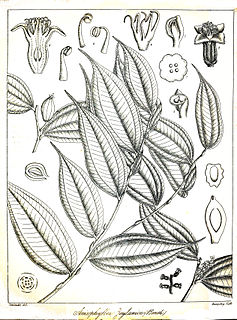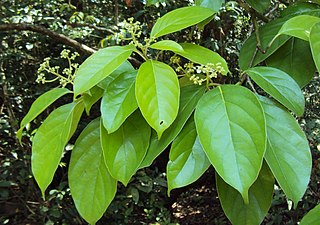
Ceiba pentandra is a tropical tree of the order Malvales and the family Malvaceae, native to Mexico, Central America and the Caribbean, northern South America, and West Africa. A somewhat smaller variety was introduced to South and Southeast Asia, where it is cultivated.

Anisophyllea is a genus of plant in the family Anisophylleaceae. The generic name is from the Greek meaning "unequal leaf", referring to the dimorphism of the leaves.

Mastixia is a genus of about 19 species of resinous evergreen trees, usually placed in the family Cornaceae. Its range extends from India through Southeast Asia and New Guinea to the Solomon Islands. Mastixia species have alternate or opposite simple broad leaves, many-flowered inflorescences, and blue to purple drupaceous fruits.
Mastixia glauca is a tree in the family Nyssaceae. The specific epithet glauca is from the Greek meaning "bluish-grey", referring to the colour of the leaf underside.
Mastixia macrocarpa is a tree in the family Nyssaceae. The specific epithet macrocarpa is from the Greek meaning "large fruit".
Barringtonia scortechinii grows as a tree up to 40 metres (130 ft) tall, with a trunk diameter of up to 40 centimetres (16 in). The bark is brown or red. Fruit is winged, up to 12 centimetres (4.7 in) long. Habitat is mixed dipterocarp forest from sea-level to 1,400 metres (4,600 ft) altitude. B. scortechinii is found in Thailand, Malaysia, Brunei and Indonesia.
Xanthophyllum pulchrum is a plant in the family Polygalaceae. The specific epithet pulchrum is from the Latin meaning "beautiful", referring to the plant's appearance.
Canarium caudatum is a tree in the family Burseraceae. The specific epithet caudatum is from the Latin meaning "tailed", referring to the tapering of the tree's leaflet.

Canarium hirsutum is a tree in the family Burseraceae. The specific epithet hirsutum is from the Latin meaning "bristly", referring to the rough hairs of the fruit.
Canarium denticulatum is a tree in the family Burseraceae. The specific epithet denticulatum is from the Latin meaning "small teeth", referring to the leaf margin.
Canarium pilosum subsp. borneensis is a subspecies of Canarium pilosum. It is a tree in the family Burseraceae. The subspecies is named for Borneo.
Dacryodes longifolia is a tree in the family Burseraceae. The specific epithet longifolia is from the Latin meaning "long leaf".
Glyptopetalum quadrangulare is a plant in the family Celastraceae. The specific epithet quadrangulare is from the Latin meaning "four-angled", referring to the winged twigs.
Kostermanthus heteropetalus is a tree in the family Chrysobalanaceae. The specific epithet heteropetalus is from the Greek meaning "uneven or unequal petals".
Mastixia cuspidata is a tree in the family Nyssaceae. The specific epithet cuspidata is from the Latin meaning "sharp-pointed", referring to the leaf apex.
Mastixia eugenioides is a tree in the family Nyssaceae. The specific epithet eugenioides is from the Latin and refers to the resemblance of the leaves to those of the genus Eugenia.
Mastixia rostrata subsp. caudatifolia is a subspecies of Mastixia rostrata. It is a tree in the family Nyssaceae. The infraspecific epithet caudatifolia is from the Latin meaning "tapered leaf".
Mastixia trichotoma is a tree in the family Nyssaceae. The specific epithet trichotoma is from the Greek meaning "three parts", referring to the three-branched inflorescence.

Cratoxylum glaucum is a plant in the family Hypericaceae. The specific epithet glaucum is from the Latin meaning "blue-green", referring to the colour of the leaf underside.
Perrottetia alpestris subsp. philippinensis is a subspecies of Perrottetia alpestris. It is a plant in the family Dipentodontaceae, sometimes classified in the family Celastraceae.




